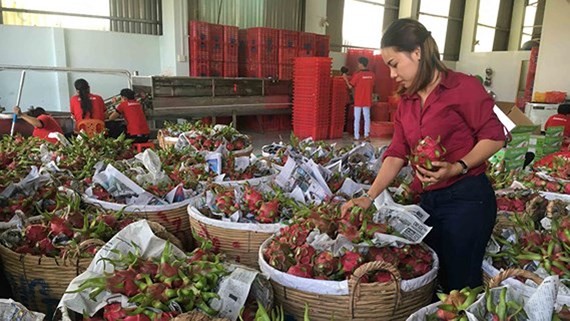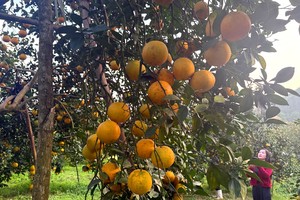
Dong Thap Province in the Mekong Delta which has strength in fruit trees has focused on developing centralized fruit growing area for years hereby establishing mango growing area in Cao Lanh District and Cao Lanh City, mandarin orange growing area in Lai Vung District and longan growing area in Chau Thanh District. The province also organizes production by connecting farmers, cooperatives and firms to meet export demand.
The Department of Agriculture and Rural Development of Dong Thap Province said that the province’s fruit production reaches 300,000 tons annually. Besides domestic consumption, fruits are exported to South Korea, Japan, Australia, New Zealand, Russia and China. Recently, the province has exported 8 tons of mangoes to the US. This is the first batch of Vietnamese mangoes that are officially allowed to be exported to this choosy market.
According to Mr. Le Quoc Doanh, deputy minister of the MARD, Vietnamese mangoes have been exported to 40 countries in the world, including demanding markets such as Japan, South Korea, the EU, Australia and Canada and now have entered the US market. In order to enter the US market, Vietnamese authorities sent application requesting the US to open door for Vietnamese mangoes in 2009. During the past years, plant quarantine agencies of the two countries had had several technical discussions in order to reach an agreement on conditions for mangoes to be imported and plans to treat mangoes by irradiation before exporting from Vietnam.
Mr. Nguyen Quang Hieu, head of the Department of International Cooperation under the Department of Plant Protection, said that in order for fresh mangoes to be exported to the US, provinces and firms have had to meet several strict requirements. As Vietnamese mangoes are accepted in the US market, prospects for export of fruits have become more optimistic.
Mr. Nguyen Thanh Hung, vice chairman of Dong Thap Province’s People’s Committee, said that by entering a choosy market like the US market, mangoes will help to increase profits and economic efficiency for farmers. However, it requires farmers to maintain the quality of the fruit and keep connection with firms in production, harvest, processing and packing in order to continue to export this kind of fruit to the US in the future. They should not be subjective and reckless although they have entered this demanding market.
Sharing the same point of view, Mrs. Nguyen Thi Hong Thu, director of Chanh Thu Import-Export Company, the company which exported the first consignment of mangoes to the US, said that it is difficult, time-consuming and costly to open a new export market for fruits. However, once a new export market is opened, it is more difficult to maintain the market. It involves strong determination of firms, farmers, cooperatives and authority to protect and develop the market together because technical barriers of import markets are always sophisticated.
The Department of Plant Protection noted that members in the WTO when exporting fresh fruits must comply with regulations on plant quarantine of the SPS Agreement and the International Plant Protection Convention which request fresh fruits to have a plant quarantine certificate granted by authorized agencies. Countries in the EU have built a set of regulations for each kind of products and they have strict control system to check products imported through the border. Violation cases will be warned and depending on extent of violations, imported products will be returned to export countries, destroyed or halted import.
China used to be considered as an easy market, now has also set up stricter barriers on plant quarantine. As a result, export via border trade has gradually been reduced. Currently, China has allowed import of eight fresh fruits from Vietnam, including dragon fruit, mango, longan, rambutan, lychee, banana, jack fruit and water melon with requirement that imported fruits must be fully checked.
The Plant Protection Department also said that as countries tend to raise plant quarantine barriers about food safety, it will be more difficult to expand export markets for fruits. In addition, Vietnamese firms also lack of researches, thorough and comprehensive forecast about demand and taste of consumers at key export market, especially information about their competitors. These are challenges for export of fruits in long term.
Experts said that, demand for fruits in the world is on the increase and Vietnam has potential to boost export of fruits in the near future. The urgent issue is that the country should build a strategy to open suitable export market and concentrate on major markets which are convenient for transport and products of Vietnam, including dragon fruit, rambutan, longan, pomelo and mango, have competitive advantage.
The country should project and develop centralized fruit growing areas for export, in which fruits will be grown under VietGAP and GlobalGAP standards and complied with requirements of import countries. At the same time, the country should have policy to invest in technology for plant quarantine, post-harvest preservation and further processing to meet requirements of import countries. In addition, the country should promote the connection between farmers and exporters to aim for a sustainable fruit production and export industry.
























